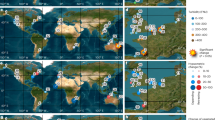Abstract
UNDERSTANDING the processes that generate and maintain patterns of species diversity is a major focus of contemporary ecological and evolutionary research. In the deep sea, species diversity varies geographically and bathymetrically1–3, and may attain levels that rival tropical communities4. Many hypotheses have been proposed concerning the forces that shape patterns of species diversity in the deep sea5, but so far it has not been possible to relate these patterns to potential causes in a direct quantitative way. The nature of sediments should be important in structuring deep-sea communities because deposit feeders rely on the sediments for nutrition and comprise most of the organisms in the deep sea6. The composition of soft sediment communities is influenced by sediment particle size7,8. Shallow-water deposit feeders selectively ingest particular size fractions of the sediments9,10 and there are interspecific differences in particle size preference11–13. Partitioning of sediments with respect to size may be more likely in the deep sea if there is strong selection for macrophagy as a result of reduced food supply and digestive constraints imposed by feeding on deposits14; macrophagy would permit species to ingest selectively the more labile components of the sediments. If deposit feeders in the deep sea partition the sediments with respect to size, species diversity may in part be a function of sediment particle size diversity. Also, sediment particle size diversity may reflect habitat complexity because the organisms live on or within the sediments15–21. Here we show that species diversity is a significant positive function of sediment particle size diversity. The relationship seems to be scale-invariant, accounting for a similar proportion of the variance at inter-regional, regional and local scales. Bathymetric patterns of species diversity also appear to be largely attributable to changes in sediment characteristics with depth. These results suggest that sediment diversity has an important role in determining the number of species within a community and identify a direct environmental factor that potentially influences species diversity in the deep sea.
This is a preview of subscription content, access via your institution
Access options
Subscribe to this journal
Receive 51 print issues and online access
$199.00 per year
only $3.90 per issue
Buy this article
- Purchase on Springer Link
- Instant access to full article PDF
Prices may be subject to local taxes which are calculated during checkout
Similar content being viewed by others
References
Sanders, H. L. Am. Nat. 102, 243–282 (1968).
Rex, M. A. A. Rev. Ecol. Syst. 12, 331 (1981).
Rex, M. A. in The Sea (ed. Rowe, G. T.) 453–472 (Wiley, New York, 1983).
Grassle, J. F. & Maciolek, N. J. Am. Nat. 139, 313–341 (1992).
Gage, J. D. & Tyler, P. A. Deep Sea Biol. 1–522 (Cambridge Univ. Press, UK, 1991).
Sanders, H. & Messier, R. Science 163, 1419–1423 (1969).
Gray, J. S. Oceanogr. mar. Biol. A. Rev. 12, 223–261 (1974).
Gray, J. S. The Ecology of Marine Sediments (Cambridge Univ. Press, UK, 1981).
Taghon, G. L. Oecologia 52, 295–304 (1982).
Self, R. F. L. & Jumars, P. A. J. mar. Res. 46, 119–143 (1988).
Fenchel, T., Kofoed, L. H. & Lappalainen, A. Mar. Biol. 30, 119–128 (1975).
Fenchel, T. & Kofoed, L. H. Oikos 27, 19–32 (1976).
Whitlatch, R. B. J. mar. Res. 38, 743–765 (1980).
Jumars, P. A., Mayer, L. L., Deming, J. W., Baross, J. A. & Wheatcroft, R. A. Phil. Trans. R. Soc. Lond. A 331, 85–101 (1990).
MacArthur, R. & MacArthur, J. Ecology 42, 594–598 (1961).
Murdoch, W. W., Evans, F. C. & Peterson, C. H. Ecology 53, 819–829 (1972).
Pianka, E. R. Evolutionary Ecology 1–397 (Harper & Row, New York, 1978).
Pielou, E. C. Ecological Diversity (Wiley, New York, 1975).
Pianka, E. R. Ecology 48, 333–351 (1967).
Heck, K. L. & Wetstone, G. S. J. Biogeogr. 4, 135–142 (1977).
Dean, R. L. & Connell, J. H. J. exp. mar. Biol. Ecol. 109, 195–215 (1987).
Blake, J. A. et al. Study of Biological Processes on the US South Atlantic Slope and Rise Phase 2. (US Dept of Interior Report, Minerals Management Service, Washington DC, 1987).
Maciolek, N. J. et al. Study of Biological Processes on the US Mid-Atlantic Slope and Rise. Phase 2. (US Dept of Interior Report, Minerals Management Service, Washington DC, 1987).
Hurlbert, S. H. Ecology 52, 477–587 (1971).
Whitlatch, R. B. J. exp. mar. Biol. Ecol 53, 31–45 (1981).
Johnson, R. J. mar. Res. 32, 313–330 (1974).
Rhoads, D. C. & Boyer, L. F. in Animal-Sediment Relations: The Biogenic Alteration of Sediments (eds McCall, P. L. & Tevesz, M. J. S.) 3–52 (Plenum, New York, 1982).
Nowell, A. R. M., Jumars, P. A. & Fauchald, K. Limnol. oceanogr. 29, 645–649 (1984).
Author information
Authors and Affiliations
Rights and permissions
About this article
Cite this article
Etter, R., Grassle, J. Patterns of species diversity in the deep sea as a function of sediment particle size diversity. Nature 360, 576–578 (1992). https://doi.org/10.1038/360576a0
Received:
Accepted:
Issue Date:
DOI: https://doi.org/10.1038/360576a0
This article is cited by
-
Macrofauna community patterns in a Chiloe Island channel used intensely for aquaculture: the ecological status of its benthic environment
Revista Chilena de Historia Natural (2021)
-
Comparative transcriptome analysis of Eogammarus possjeticus at different hydrostatic pressure and temperature exposures
Scientific Reports (2019)
-
Bathynomus giganteus (Isopoda: Cirolanidae) and the canyon: a population genetics assessment of De Soto Canyon as a glacial refugium for the giant deep-sea isopod
Hydrobiologia (2018)
-
Review of recent trends in ecological studies of deep-sea meiofauna, with focus on patterns and processes at small to regional spatial scales
Marine Biodiversity (2018)
-
Macrofauna abundance, species diversity and turnover at three sites in the Clipperton-Clarion Fracture Zone
Marine Biodiversity (2017)
Comments
By submitting a comment you agree to abide by our Terms and Community Guidelines. If you find something abusive or that does not comply with our terms or guidelines please flag it as inappropriate.



